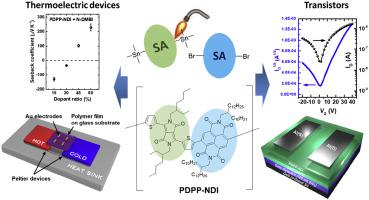Organic Electronics ( IF 2.7 ) Pub Date : 2020-08-14 , DOI: 10.1016/j.orgel.2020.105921 Moon-Ki Jeong , Eui Hyun Suh , Kyumin Lee , Jaeyoung Jang , In Hwan Jung

|
The development of n-type conjugated polymers (CPs) forming an acceptor–acceptor (A–A)-type structure are quite challenging due to the synthetic limitation of imposing a functional group on the electron deficient aromatic structure. The diketopyrrolopyrroles (DPP) structure exhibits n-type characteristics; however, the extended π-structure enables stannylation at the terminal position. The stannylated DPP is beneficial for making n-type CPs, but its use in the development of n-type CPs and their application in n-type organic thin-film transistors and organic thermoelectric devices have been not extensively studied. In the present study, we synthesized the A–A-type conjugated polymer, poly [((2,5-bis(2-ethylhexyl)-3,6-di(thiophen-2-yl)-2,5-dihydropyrrolo [3,4-c]pyrrole-1,4-dione)-5,5′-diyl)-alt-((2,7-bis(2-ethylhexyl)benzo [lmn] [3,8]phenanthroline-1,3,6,8(2H,7H)-tetraone)-4,9-diyl))] (PDPP-NDI), by Stille coupling of distannylated DPP and dibrominated naphthalene diimide (NDI). The alternating copolymerization of DPP and NDI moieties led to a low-lying LUMO energy level of −4.4 eV, suitable for electron transport. The n-type organic thin-film transistors were fabricated with PDPP–NDI, and a substantial average electron mobility of 3.78 × 10−2 cm2 V−1 s−1 was obtained after thermal annealing. The n-type organic thermoelectric devices were developed via n-doping, and PDPP–NDI exhibited n-type thermoelectric properties, with an average power factor of 1.82 × 10−3 μW m−1 K−2.
中文翻译:

用于n型有机薄膜晶体管和热电器件的受体-受体型共轭聚合物
由于在电子缺陷型芳香族结构上加成官能团的合成限制,形成受主-受主(AA)型结构的n型共轭聚合物(CP)的开发非常具有挑战性。二酮吡咯并吡咯(DPP)结构表现出n型特征。但是,扩展的π结构可以在末端位置进行甲锡烷基化。锡烷基化的DPP有利于制造n型CP,但是它在n型CP的开发中的应用及其在n型CP中的应用尚未广泛研究类型的有机薄膜晶体管和有机热电器件。在本研究中,我们合成了A–A型共轭聚合物,聚[(((2,5-双(2-乙基己基)-3,6-二(噻吩-2-基)-2,5-二氢吡咯[ 3,4- ç ]吡咯-1,4-二酮)-5,5'-二基) - ALT - ((2,7-双(2-乙基己基)苯并[LMN] [3,8]菲咯啉-1, 3,6,8(2 H,7 H)-tetraone)-4,9-diyl))](PDPP-NDI),通过二苯甲酰化DPP和二溴化萘二酰亚胺(NDI)的Stille偶联。DPP和NDI部分的交替共聚导致−4.4 eV的低态LUMO能级,适合电子传输。该ñ用PDPP-NDI制造了有机型有机薄膜晶体管,并且在热退火之后获得了实质上的平均电子迁移率,为3.78×10 -2 cm 2 V -1 s -1。的Ñ型有机热电装置被开发经由Ñ掺杂,和PDPP-NDI表现出Ñ型热电性能,具有1.82×10的平均功率因子-3 μW米-1 ķ -2。











































 京公网安备 11010802027423号
京公网安备 11010802027423号